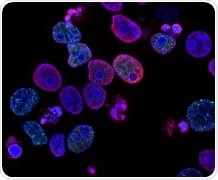An innovative new method for more efficient and accurate barcoding of individual cells could help realize faster diagnosis of diseases.

The new technique could revolutionize the crucial early diagnosis of some of the most debilitating and life-threatening diseases, including cancer. Image Credit: University of Exeter.
Scientists from the Living Systems Institute at the University of Exeter have devised a new technique that integrates artificial intelligence and microfluidics to easily sort, classify, and count individual cells.
The pioneering new method enables researchers to perform complex and detailed analyses of single cells, such as mammalian cells, in real-time. Earlier, there have been no common techniques for accurate sampling and barcoding of isolated single cells without high wastage while performing the sampling process.
However, this new technique enables researchers to barcode individual cells with more accuracy and efficiency than before to measure their molecular composition, which is a highly critical advancement as diseases are usually caused by the malfunction of a few cells.
The new method could completely transform the critical early diagnosis of a few of the most life-threatening and debilitating diseases, such as cancer. The research was published in the Advanced Materials Technologies journal.
With the technology we have developed, we have the opportunity to advance our understanding of the origin of differences observed between cells in a population. These differences are seen at the molecular level and are especially large during key cell stages such as differentiation into specialised cells, but can also be indicative of early cancer development.”
Dr Fabrice Gielen, Study Principal Investigator, Living Systems Institute, University of Exeter
“We have applied our tool for screening of thousands of single cells from real-time imaging data and efficiently barcode them with minimum cell waste,” added Dr. Gielen.
We are currently applying this tool to screen miniature in-vitro tumours formed from model neuroblastoma cells to understand why cancer progression appears to be highly unpredictable in clinical settings. This may lead to early diagnostics and the use of targeted therapeutics.”
Dr Fabrice Gielen, Study Principal Investigator, Living Systems Institute, University of Exeter
“Our technique being generic in scope, we also foresee plenty of further opportunities enabled by real-time image analyses such as the study of bacterial biofilm formation and the degradation of plastic microfibers by biocatalysts,” Dr. Gielen concluded.
Source:
Journal reference:
Howell, L., et al. (2021) Multi-Object Detector YOLOv4-Tiny Enables High-Throughput Combinatorial and Spatially-Resolved Sorting of Cells in Microdroplets. Advanced Materials Technologies. doi.org/10.1002/admt.202101053.